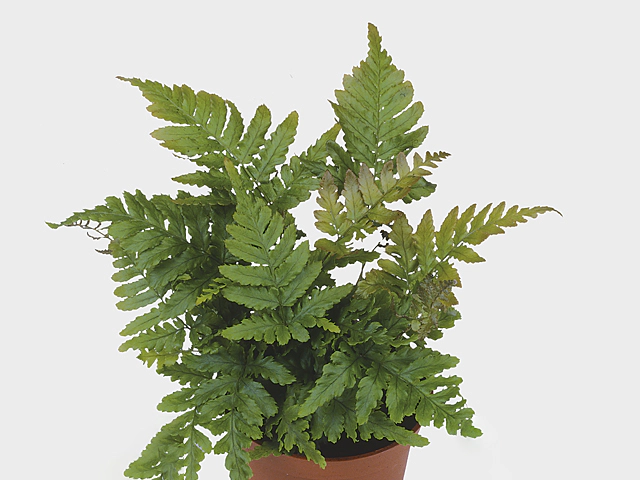Dryopteris erythrosora

| Leaf margin | Serrate |
| Leaf type | Foliage leaf |
| Winter hardness | Reasonable (USDA-zone 7) |
| Leaf, general shape | Triangular |
| soil pH requirement | Slightly acidic (pH 4,5 - 6,5); Neutral (pH 6,5 - 7,5) |
| Light conditions | Semi-shades |
| Leaf division | Pinnate |
| Plant, growth type | Erect |
| Leaf, main color | Medium brown; Dark green |
| Leaf colour, pattern | Bicolored |
| Toxicity (if consumed) | Fairly |
| Moisture requirements | Moist |
The Dryopteris erythrosora, also known as the Japanese Shield Fern, is a unique and beautiful plant that adds a touch of elegance to any garden or landscape. With its serrated leaf margins and foliage leaf type, it stands out among other ferns.
One of the notable features of this fern is its ability to withstand winter conditions relatively well. With a reasonable winter hardness, it can thrive in USDA-zone 7 regions, making it a suitable choice for gardens in areas with moderate cold temperatures.
The leaves of the Dryopteris erythrosora have a distinct triangular shape, adding an interesting visual element to the plant. Additionally, its pinnate leaf division gives it a feathery appearance that is both delicate and charming.
When it comes to soil preferences, this fern adapts well to slightly acidic pH levels ranging from 4.5 to 6.5. However, it can also tolerate neutral pH levels between 6.5 and 7.5, allowing for flexibility in various soil compositions.
In terms of light conditions, the Japanese Shield Fern prefers semi-shaded areas. While it can tolerate some sunlight, it thrives best in areas with filtered or indirect light. This makes it a suitable choice for planting under taller trees or in shaded corners of the garden.
The main color of the Dryopteris erythrosora's leaves varies between medium brown and dark green, giving it an attractive and distinctive appearance. In addition, the leaf color pattern is bicolored, further enhancing its visual appeal.
It's important to note that this fern has a moderately toxic nature if consumed. Therefore, it's advisable to keep it out of reach of pets and children. While it may be safe for most individuals, it's always best to err on the side of caution.
Lastly, the Japanese Shield Fern has moderate moisture requirements, thriving in moist conditions. It performs best in well-draining soils that retain moisture without becoming waterlogged. Regular watering should be provided to keep the soil consistently damp but not excessively saturated.
In conclusion, the Dryopteris erythrosora, or Japanese Shield Fern, is a botanical gem that offers unique features such as serrated leaf margins, pinnate leaf division, and a bicolored leaf color pattern. Its adaptability to winter conditions, preference for semi-shaded areas, and moderate moisture requirements make it a valuable addition to any garden or landscape design. Consider incorporating this fern into your outdoor space to enjoy its beauty and charm.
Market availability index by month:
| Jan. | Feb. | Mar. | Apr. | May | Jun. | Jul. | Aug. | Sep. | Oct. | Nov. | Dec. |
|---|---|---|---|---|---|---|---|---|---|---|---|
| 4 | 3 | 3 | 3 | 3 | 3 | 3 | 3 | 3 | 3 | 3 | 3 |